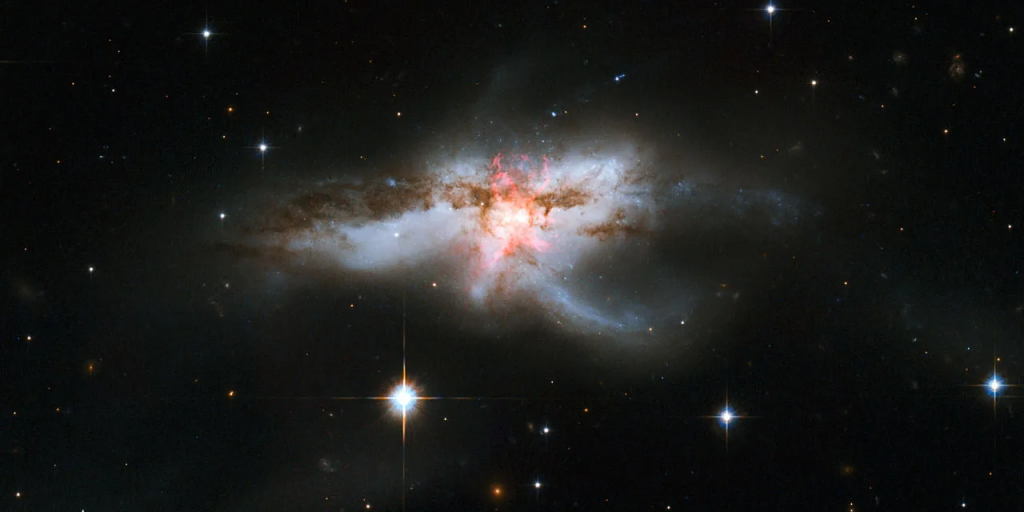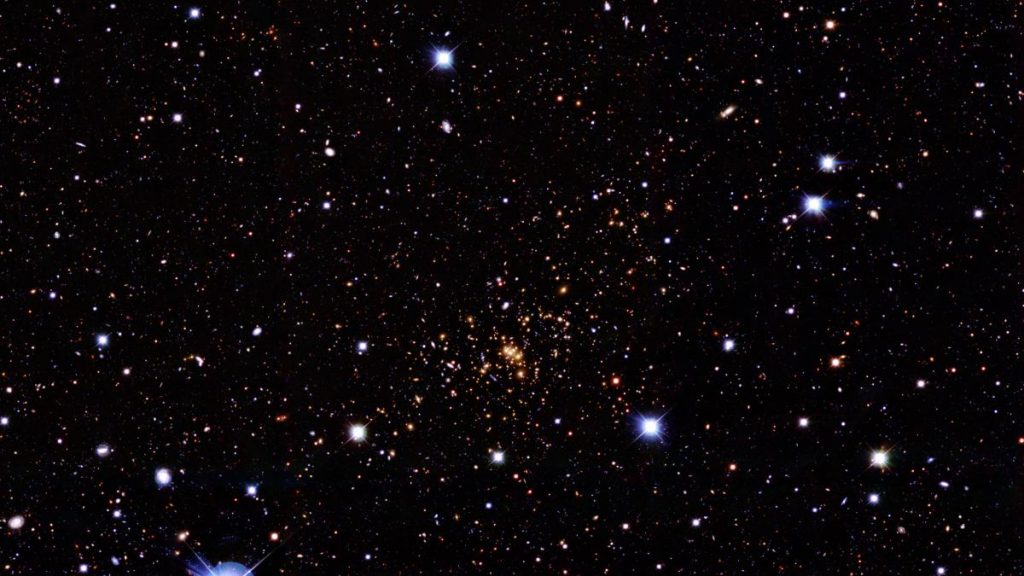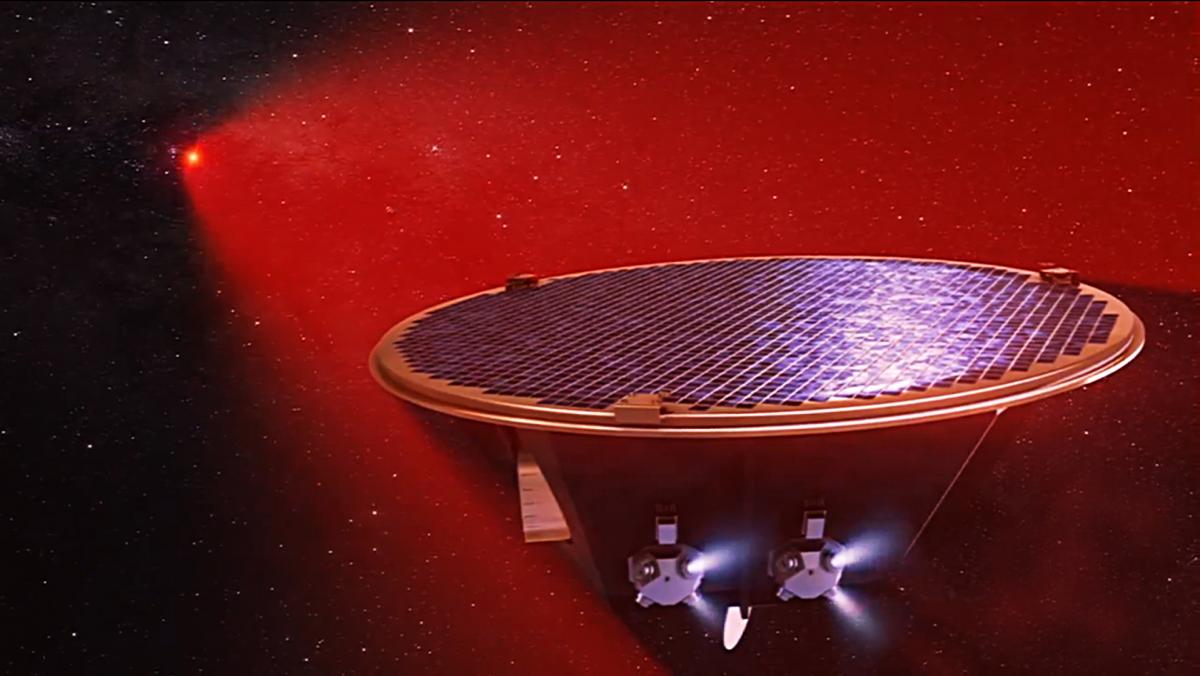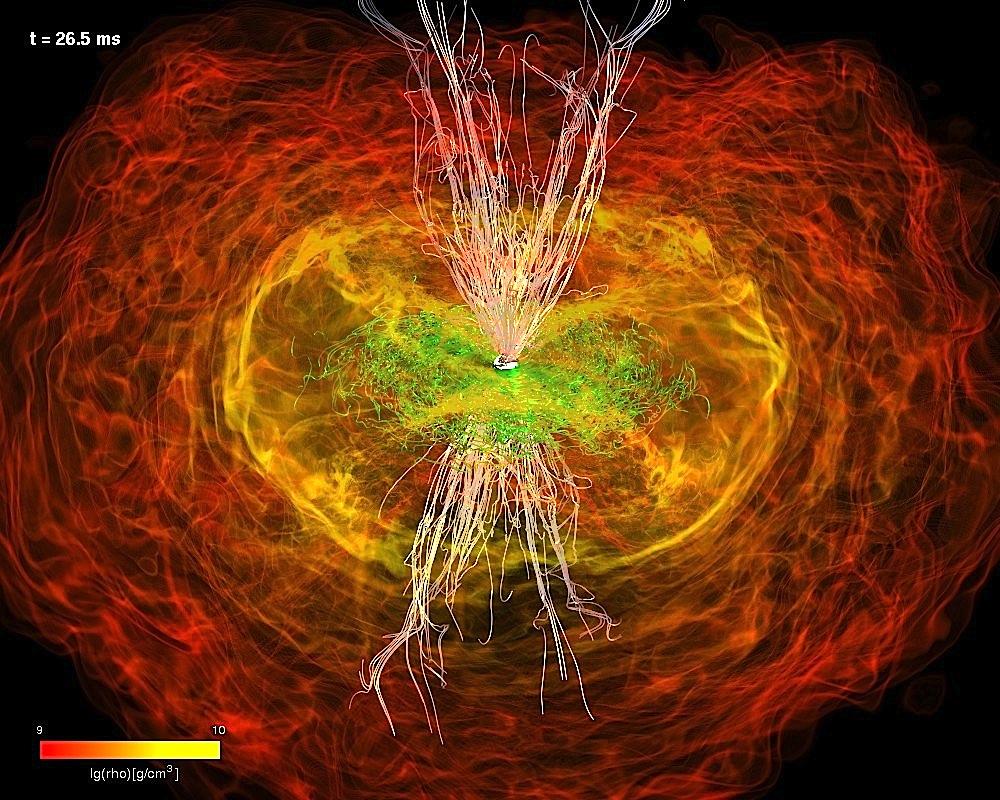Studying gravitational waves has enormous potential for discovering those parts of the Universe that are not yet observed such as the gravitational repercussions from the Big Bang, the ripples of spacetime emerging from perturbations of the primaeval plasma, and other, as yet unknown, objects. Working in conjunction with other astronomical methods and gravitational-wave observatories on Earth, LISA scientists will contribute to the next big discoveries to answer questions such as “What are the fundamental laws of the Universe?” and “How did the Universe originate and what is it made of?
Merging intermediate-mass black holes
Intermediate to massive black holes with masses in the interval between 10 000 and 10 000 000 solar masses will be detected by LISA, to explore for the first time the low-mass end of the massive Black hole population, at cosmic times as early as z ~ 10.
The Gravitational Universe will make it possible to survey the vast majority of all coalescing massive black hole binaries throughout the whole universe. This will expose an unseen population of objects which will potentially carry precious information about the black hole population as a whole. It will provide both the widest and deepest survey of the sky ever, since gravitational wave detectors are non-directional in nature, and operate as non-pointed and weakly directional full-sky monitors. The range of black hole redshifts and masses that will be explored is complementary to the space explored by electromagnetic observations.
LISA will detect all binary black hole mergers even when the black holes are not active. With this unbiased and complete survey, it will be possible to investigate the link between the growing seed population with the rich population of active supermassive black holes evolving during cosmic dawn and high noon, probing the light end of the mass function at the largest redshifts.
Black hole coalescence events will illuminate the physical processes of black hole formation and feeding. While the mass distribution carries information about the seeds, the spin distribution charts the properties of the accretion flows, whether they are chaotic or coherent. Gravitational wave observations alone will be able to distinguish between the different massive Black hole formation and evolution scenarios.
Gravitational-wave background
LISA will be able to detect a gravitational-wave background emitted at the beginning of the universe. This will help us to probe the universe just afte the Big Bang.

Gravitational waves are the next messengers to probe the very early Universe, after the cosmic microwave background. LISA is sensitive to gravitational waves that may have been produced when the early Universe plasma cooled below a billion billion Kelvin at roughly a billionth-billionth of a second after the big bang. Such energies (of hundreds of TeV) are inaccessible to current laboratory experiments, but may be within reach of far future particle colliders.
LISA will be able to gather information on the state of the Universe at much earlier epochs than those directly probed by any other cosmological observation, thereby helping us on our quest to understand the earliest moments of the Universe.
Exotic sources
LISA can help us probe the unknown and test for new physics, such as the existence of extra dimensions or cosmic super-strings.
With LISA, we will continue our search for the (currently) unknown, in the hope of finding new physics. Amongst other things, we will be able to search for the existence of extra dimensions, cosmic superstrings predicted by string theory, and investigate the nature of dark matter.
The LISA frequency band corresponds to horizon scales in the early Universe at energies of the order of the TeV, where new physics, such as extra dimensions, is expected to become visible. One of the effects of the new physics are primordial first order phase transitions, proceeding through the explosive growth of broken phase bubbles, and leading to efficient gravitational wave production.
LISA will also provide a unique probe on cosmic (super-)strings, relics of the very early Universe at even higher energy scales, which are predicted in several theories unifying the fundamental interactions of nature, including string theory. Their detection would offer direct evidence for phenomena occurring at energies up to 1016 GeV and which are not observable with conventional astronomy.
Through gravitational wave detection, LISA is therefore capable of probing energy ranges much beyond the reach of present particle accelerators and gather informations on the state of the Universe at much earlier epochs than those directly probed by any other cosmological observation. Gravitational waves represent the next messenger to probe the very early Universe, after the use of the Cosmic Microwave Background.
White dwarf binary systems
LISA will be able to detect gravitational waves from white dwarf binaries when they are still far apart.
The waves from these systems will enter the frequency band of current and future generation ground-based gravitational-wave detectors as they get closer to merger and can then be observed on Earth. Using both LISA and the ground-based observatories, we will thus be able to observe these binary systems in the gravitational-wave spectrum across a great part of their existence.

White dwarf binaries have been detected by electromagnetic observations and are known to exist in plenty across our galaxy.
LISA guarantees the detection of gravitational waves by monitoring the most promising of these known nearby galactic binary systems, which we sometimes call “verification binaries”. Gravitational waves from neutron star binaries will allow us to explore extremely dense matter systems, stellar evolution and high-energy astrophysics. LISA will detect these systems before they enter the ground-based band, allowing us to constrain their
Extreme-mass-ratio inspirals
The inspiral of a stellar-mass black hole and supermassive black hole. Their gravitational waves will allow us to test the theory of general relativity.
When a stellar-mass black hole orbits a supermassive black hole it undergoes hundreds of thousands of orbital cycles. The smaller black hole acts as a probe, mapping out the geometry of the surrounding spacetime. This information will be encoded into the gravitational waves emitted during the inspiral of the system. With the detection of these waves we will be able to test Einstein’s theory of general relativity, by examining the force of gravity in its strongest regime within the cosmos.
Supermassive black hole binaries
Supermassive black hole binaries are the strongest sources of gravitational radiation in the universe. From them, we will learn more about galactic formation and structure.
When two black holes are locked in orbit they emit gravitational waves which causes them to lose energy, leading to an inspiral and collision of the system.

Credit: NASA, ESA, the Hubble Heritage (STScI/AURA)-ESA/Hubble Collaboration, and A. Evans (University of Virginia, Charlottesville/NRAO/Stony Brook University)
The emitted gravitational waves contain information about the two bodies and the surrounding spacetime. Ground-based gravitational-wave detectors have now observed many binaries whose components are stellar-mass black holes, weighing tens of solar masses.
LISA will detect binaries whose components are supermassive black holes, weighing up to several tens of millions of solar masses. Information from their gravitational waves will provide us with rich insight into galactic formation and structure, across the observable Universe.
Compact objects merging into supermassive black holes
LISA explores the populations of stellar-mass compact objects in galactic nuclei and their dynamics. It will capture gravitational wave signals from inspiraling stellar-mass compact objects into massive black holes in galactic nuclei.
Large populations of stellar-mass black holes, neutron stars, and white dwarf stars are expected to be present in the galactic centres. All these compact objects might reach the last stable orbit around the massive black hole before being torn apart by the hole´s gravity. Some of these objects will move on nearly-radial orbits around the central black hole, others will be scattered in, close to the massive black hole, following resonant interactions with other stars present in the surroundings.
All of them will be captured on relativistic orbits.

The resulting binaries, with very small mass ratios, will become more and more compact by losing energy to gravitational radiation and later coalesce in what are called EMRIs – Extreme Mass Ration Inspirals. The strongest signals will come from stellar-mass black holes. Because they are heavier than other stars they will be more concentrated near the centres of galaxies.
LISA will have the capability of detecting EMRI signals up to redshift z ~ 0.5 – 0.7, and of measuring the mass and spin of the massive black hole with high accuracy, and in galaxies of all types. Thus it will provide a census of the massive black hole populations in the near universe in a mass interval around 104 M⊙ – 106 M⊙ for which electromagnetic observations are incomplete or even missing.
See a movie of an EMRI event (Credit: Steve Drasco).
LISA´s detections will provide unique information also on the mass spectrum of stellar black holes, in particular their upper mass limit, which is unconstrained observationally and for which we have poor knowledge from stellar evolution models.
EMRI detections will further carry information, albeit indirect, into the dynamical processes involving the various stellar populations present in the extreme environments of a galactic nucleus. LISA also has the potential of discovering a coalescence event involving two middleweight black hole of thousands suns in colliding star clusters, in the local universe. This would resolve the longstanding issue on the presence of central black holes in stellar systems as the old globular clusters.
LISA Intro
LISA, the Laser Interferometer Space Antenna, will be the first Gravitational Wave Observatory in space. It will allow us to observe the entire universe including areas that are inaccessible by other means.
With LISA we will be able to look back at the very beginning of the universe, investigate its evolution further and learn much about its structure.
LISA will complement earth-bound gravitational wave observatories and other astronomical instruments, and significantly enrich Multimessenger astronomy.
LISA´s core technologies were already successfully tested with the LISA Pathfinder mission. Now, an international consortium of scientists together with ESA and NASA is working towards LISA´s launch.
The First Gravitational Wave Observatory in Space
The first direct detection of gravitational waves in 2015, was a major scientific breakthrough. It opened the era of gravitational wave astronomy. Here on Earth gravitational wave detectors can observe high-frequency gravitational waves. They originate from objects with small masses, a few 10’s that of the Sun.
Sources with much larger masses, such as the mergers of massive black holes at the centres of galaxies, produce signals at much lower frequencies, undetectable on Earth. LISA will detect such signals and allow us unique insights in our universe – its beginning and evolution, its population, maybe the big bang and so-far unknown components.

View of a LISA Sciencecraft
© AEI/Milde Science Communication/exozet
Mission Concept
The LISA mission consists of three spacecraft orbiting the Sun in a triangular configuration. The three satellites, separated by 2.5 million km, will be connected by laser arms forming a high precision instrument – the first laser interferometer in space. It will sense gravitational waves by monitoring the minute changes in distance between free falling test masses inside the spacecraft.
LISA will be an astronomical observatory of unprecedented versatility and range.
LISA Pathfinder successfully tested core technologies
LISA´s core technologies were successfully tested with the LISA Pathfinder mission and already inspired other projects. One example is the Laser Ranging Instrument: Developed for LISA and tested on LISA Pathfinder it currently flies on the GRACE Follow-On mission and helps observing the Earth´s water movements across the planet – an important contribution to climate research.
What makes LISA so exciting?
Gravity is the dominant force in the universe
Gravity is an incredible powerful force. It drives many of the universe’s processes but so far, much of its action is invisible. This is why we want to measure gravity´s messengers: gravitational waves.
Gravitational waves are ripples in the fabric of space-time. They travel undisturbed through the universe and contain unique information. LISA will be the first ever misson to detect gravitational waves from space and thus observe the entire universe. LISA will listen to gravity and let us go further than any other astronomical method.
LISA will be a milestone for Multimessenger astronomy
Gravitational waves are fundamentally different from electromagnetic waves such as visible light, infrared or x-rays. This is why LISA will perfectly complement traditional astronomical observations.
LISA will open the gravitational wave window in space and measure gravitational radiation over a broad band of frequencies. This will enrich our knowledge about the Universe substantially.
New technology: LISA will consist of sciencecraft
The classical distinction between a spacecraft and its payload doesn’t fit the LISA mission well. Usually, a spacecraft provides the infrastructure for the scientific instruments, the payload, it carries. LISA is different because each of its spacecraft is part of the scientific instrument – it protects key elements, the free-falling test masses, from disturbances.
The LISA spacecraft must thus be designed and built with special requirements in mind. The importance of the co-design and the co-operation of spacecraft and payload is captured in the term “sciencecraft”.
Only in space: The long-baseline interferometer
LISA is so valuable for astronomers all over the world because it will measure low-frequency gravitational waves that cannot be observed from earth due to armlength limitations and terrestrial gravity gradient noise.
The ideal instrument for measuring low-frequency gravitational waves is a laser interferometer with an arm length as large as possible and long integration times. Hence LISA can be thought of as a high precision Michelson interferometer in space with an arm length of 2.5 million km. The arm length has been carefully chosen to allow observation of most of the interesting sources of gravitational waves in the target frequency band.
LISA will be an astronomical observatory of unprecedented versatility and range.
LISA´s key features and sensitivity
Key features of LISA are interferometric measurement of distances, long baselines of 2.5 x 106 km, drag free sciencecraft based on inertial sensors, and the familiar “cartwheel”-orbits. Compared to the Earth-bound gravitational wave observatories LISA addresses the much richer frequency range between 0.1 mHz and 1 Hz.
What are gravitational waves?
Gravitational waves are ripples in the fabric of space-time generated by some of the most powerful astrophysical events – such as exploding stars and collisions of two black holes at the centres of galaxies. Gravitational waves travel at the speed of light through the universe, unhindered by intervening mass – to gravitational waves the universe is transparent. That is why gravitational waves are the cosmic messengers that allow us to explore the so far dark side of the universe.
In September 2015, the first direct detection of gravitational waves by the ground-based LIGO Observatories added a new sense to our perception of the Universe: for the first time we were able to LISTEN to the Universe because gravitational waves are in some respects similar to sound waves. Hence gravitational wave astronomy complements our understanding of the Universe and its evolution.

Gravitational waves measured by LISA, a large mission in space, will allow us, for example, to trace the formation, growth, and merger history of massive black holes. Also it will enable us to confront General Relativity with observations, and it will probe new physics and cosmology with gravitational waves.
Gravity rules
Albert Einstein revealed that gravity rules the universe. According to his theory of general relativity gravity determines the curvature of space-time – the deformation of space-time depends on the position of masses and on their acceleration. Accelerating masses thus create gravitational waves – distortions in space-time that ripple outwards like waves on a pond.
In a pure gravitational environment all masses follow space-time along the straightest paths possible through this curved arena. The “straight line” to curved space-time is called a “geodesic”. Gravitational waves are waves in the fabric of space-time. They change approximately parallel geodesics, pushing them together and then pulling them apart. Two free falling test masses will experience this as an oscillating change in the relative distance to each other. ESA´s technology test mission LISA Pathfinder (LPF) has demonstrated this effect.
Gravitational waves within general relativity
With his theories of relativity Einstein laid the foundation for much of modern physics. Fundamental ideas of his theories are:
- The speed of light is constant.
- Space, time and gravity are strongly connected to each other.
- Space and time are flexible. They change according to circumfluent mass: stationary mass changes space.
- Accelerating masses create gravitational waves – distortions in space-time that ripple outwards like waves on a pond.
In General Relativity gravity is no longer simply a force that pulls falling apples to the ground. Instead, gravity is geometry. The presence of matter alters the geometry of space and time, and the geometry in turn determines how matter and light moves. Einstein predicted in 1916 that space-time would be curved and that matter and light follow the curvature of space-time (geodesics). This was experimentally observed as early as in 1919 by Arthur Eddington.
External Links
Learn more about Einstein’s Theories of Relativity at Einstein Online